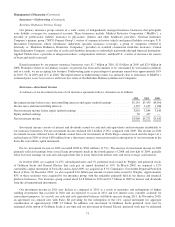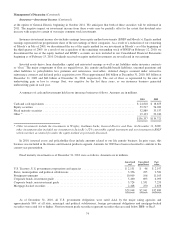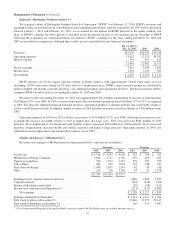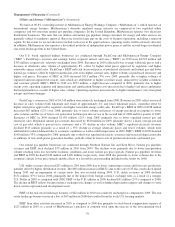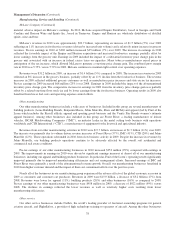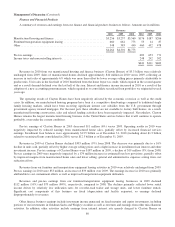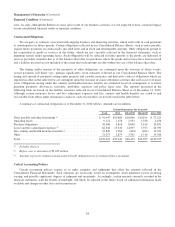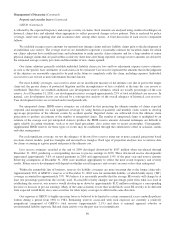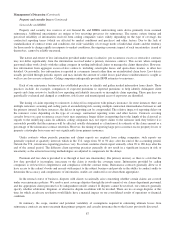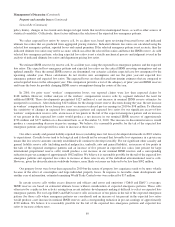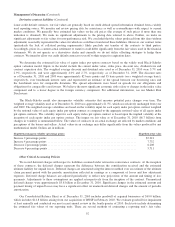Berkshire Hathaway 2010 Annual Report Download - page 85
Download and view the complete annual report
Please find page 85 of the 2010 Berkshire Hathaway annual report below. You can navigate through the pages in the report by either clicking on the pages listed below, or by using the keyword search tool below to find specific information within the annual report.Management’s Discussion (Continued)
Financial Condition (Continued)
Consolidated cash and investments of insurance and other businesses approximated $147.7 billion at December 31, 2010
including cash and cash equivalents of $34.8 billion. These assets are held predominantly in our insurance businesses. In
February 2010, we acquired all of the outstanding shares of BNSF common stock that we did not already own for aggregate
consideration of approximately $26.5 billion. The consideration paid included $15.9 billion in cash consisting of $8.0 billion in
proceeds from newly issued parent company debt (which included $2.0 billion that matured in February 2011) and $7.9 billion
of cash on hand, plus Berkshire Class A and B common stock with an aggregate value of approximately $10.6 billion.
Our railroad, utilities and energy businesses conducted by MidAmerican and BNSF maintain very large investments in
property, plant and equipment and will regularly make significant capital expenditures in the normal course of business. Capital
expenditures of MidAmerican in 2010 were approximately $2.6 billion. For the period between February 13, 2010 and
December 31, 2010, BNSF’s capital expenditures were approximately $2.3 billion, including additions to other assets.
MidAmerican’s forecasted capital expenditures for 2011 are approximately $3.1 billion. BNSF’s forecasted capital expenditures
and commitments for 2011 are approximately $3.5 billion. Future capital expenditures are expected to be funded from cash
flows from operations and debt proceeds. Aggregate borrowings of the railroad, utilities and energy businesses were about
$31.6 billion as of December 31, 2010, including $12.0 billion of borrowings of BNSF. BNSF, MidAmerican, and their
operating subsidiaries have debt and capital lease maturities in 2011 of approximately $2.2 billion. Berkshire has committed
until February 28, 2011 to provide up to $3.5 billion of additional capital to MidAmerican to permit the repayment of its debt
obligations or to fund its regulated utility subsidiaries. In 2010, the commitment was amended to extend the term of the
commitment to February 28, 2014 and to reduce the commitment to $2 billion beginning on March 1, 2011. Berkshire does not
intend to guarantee the repayment of debt by BNSF, MidAmerican or any of their subsidiaries.
Assets of the finance and financial products businesses, which consisted primarily of loans and finance receivables, fixed
maturity securities, other investments and cash and cash equivalents, were approximately $25.7 billion as of December 31, 2010
and $25.1 billion at December 31, 2009. Liabilities were approximately $24.0 billion as of December 31, 2010 and 2009. As of
December 31, 2010, notes payable and other borrowings of $14.5 billion included approximately $11.5 billion par amount of
notes issued by BHFC. In 2010, BHFC issued at various dates, notes with aggregate par amounts of $1.5 billion and repaid
maturing notes with aggregate par amounts of $2.0 billion. In January 2011, BHFC issued an additional $1.5 billion of notes and
repaid $1.5 billion of maturing notes. BHFC notes are unsecured and mature at various dates from 2011 to 2040. The proceeds
from the BHFC notes are used to finance originated and acquired loans of Clayton Homes. The full and timely payment of
principal and interest on the BHFC notes is guaranteed by Berkshire. Other debt of our finance and financial products
businesses increased in 2010 by approximately $1.2 billion to $2.9 billion primarily due to the adoption of ASU 2009-16 and
ASU 2009-17, which eliminated the concept of qualifying special purpose entities (“QSPE’s”) and the exemption of QSPE’s
from previous consolidation guidance and which amended the standards related to consolidation of variable interest entities. See
Note 1(t) and 14 to the Consolidated Financial Statements.
During 2008 and continuing into the first part of 2009, access to credit markets became limited as a consequence of a
worldwide credit crisis. However, management believes that the credit crisis has abated and as a result, interest rates for
investment grade issuers relative to government obligations have declined. Nevertheless, restricted access to credit markets at
affordable rates in the future could have a significant negative impact on our operations, particularly the railroad, utilities and
energy and the finance and financial products operations. On July 21, 2010, President Obama signed into law financial
regulatory reform legislation, known as the Dodd-Frank Wall Street Reform and Consumer Protection Act (the “Reform Act”).
The Reform Act reshapes financial regulations in the United States by creating new regulators, regulating new markets and
firms, and providing new enforcement powers to regulators. Virtually all major areas of the Reform Act will be subject to
regulatory interpretation and implementation rules requiring rulemaking that may take several years to complete.
We are party to several equity put option and credit default contracts as described in Note 11 to the Consolidated Financial
Statements. With limited exception, these contracts contain no collateral posting requirements under any circumstances,
including changes in either the fair value or intrinsic value of the contracts or a downgrade in Berkshire’s credit ratings.
Substantially all of these contracts were entered into prior to December 31, 2008. At December 31, 2010, the net liabilities
recorded for such contracts were approximately $8.0 billion and our collateral posting requirements were $31 million. With
respect to such collateral requirements, we receive the income attributable to such collateral or, in certain instances, interest
credit from the counterparty. Although the ultimate outcome of the regulatory rulemaking proceedings described in the
preceding paragraph cannot be predicted with certainty, we do not believe that the provisions of the Reform Act that concern
collateral requirements apply to derivatives contracts that were entered into prior to the enactment of the Reform Act, as ours
83


